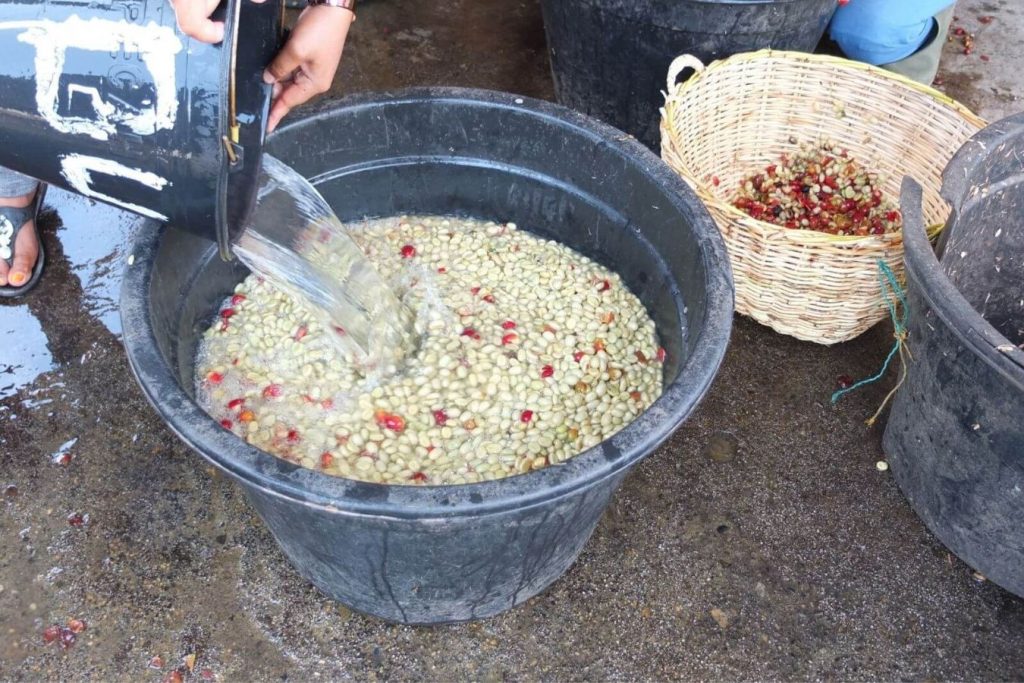Learn About Coffee’s Wet Processing Procedure
Unlike the dry coffee processing method, which involves drying or drying the coffee berries before crushing them to obtain the bean. Wet processing necessitates more complex processes and modern gear and is typically reserved for high-quality Arabica coffee.
Because the coffee beans are acidic, damp processing is usually avoided with Robusta coffee. When Robusta coffee is processed using the wet method, it produces a robust sour flavor that is unpleasant to taste. As a result, Robusta coffee is frequently processed dry.
The Wet Processing Method Is Used To Process Coffee (Washed Coffee)
Coffees classification
Because coffee berries do not always ripen evenly on the tree, choosing and classifying the best coffee berries is required before putting them into the production process and eliminating defective and damaged berries.
After harvesting, coffee is carried to the processing location and promptly soaked in a large water tank for sorting. The ripe fruit that has been dry and damaged will become light and float to the water’s surface. The mature, ripe fruit will sink into the water in the meanwhile. Branches, leaves, and contaminants clinging to coffee berries will also be removed.
Take out the coffee capsules
The principal element in the skin of the coffee berry is cellulose, which is extremely thick and difficult for microorganisms to degrade in natural settings. As a result, the coffee must be peeled before being used in the fermenting process.
This is the most crucial stage in the entire wet processing process. Separating the coffee beans must be completed swiftly to avoid the development of odd flavors in the beans if they are kept in the natural environment for an extended period.
Mucus is removed during fermentation
Because the flavor of the coffee will be directly altered during this process, the processor must exercise extreme caution. Following the separation of the pods, the coffee must be steeped in the water tank to begin the fermentation process. The amount of water used in wet processing varies, although it is usually 1:1.
Fermentation can occur naturally without water tanks in some regions where water is scarce. This technique is also known as honey processing or semi-wet processing.
Ferment
The length of time it takes for coffee to ferment is determined by several factors, including altitude and ambient temperature. As the temperature rises, coffee will quickly ferment. However, it is vital to keep track of the time throughout this period to avoid affecting the coffee’s quality.
Some manufacturers use manual ways to check if the coffee has matured appropriately, such as rolling coffee beans between two fingers. The procedure is complete when the grain surface is smooth, has friction, and generates a hissing sound.
Sticking a long plant in the fermenter is another method to test it. This stage is complete if the plant can stand erect because it is supported by water containing a lot of pectins, which are produced during fermentation.
Thoroughly clean and dry the coffee beans
The coffee will be rinsed after successfully fermented to remove contaminants from the beans. The coffee beans will then be dried in the sun. It’s also important to stir the seeds frequently while avoiding a situation where the roots are dry yet moist and moldy.
In addition, the seed dryer can be employed in low-light or high-humidity situations. On the other hand, sun-dried coffee beans will be of considerably higher quality.
Wet-processed Coffee Characteristics According to the Wet-processing Method
Benefits
The producer has improved the flavor quality of the coffee by using the wet processing procedure. Because coffee beans are fermented by enzymes or microorganisms contained in the beans during damp processing, superior flavor quality is maintained. This wet processing aids in the development of optimal flavor in seed varietals such as Arabica.
Negative aspects
The operator must have a high level of knowledge to accomplish the wet processing process for coffee beans.
To ensure the most refined taste and quality of coffee, you must also attentively watch any changes during the fermentation process. Furthermore, putting this strategy into practice necessitates a high initial investment, a sophisticated machinery system, and a significant amount of water.

